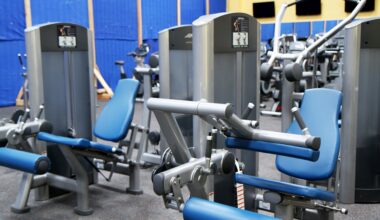Flexibility and Strength: Combining Bodyweight Exercises for Seniors
For seniors, engaging in bodyweight exercises can be a fantastic way to promote both flexibility and strength. These exercises are particularly beneficial since they do not require any equipment and can be performed at home. Seniors can focus on movements that enhance balance and core strength, which are vital for daily activities. Incorporating exercises such as squats, lunges, and push-ups can significantly improve body stability. Additionally, working out with bodyweight provides a lower risk of injury compared to using weights. It is essential for older adults to consult with a healthcare provider before starting any new workout regimen. Regular workouts can also release endorphins, helping to boost mood and reduce feelings of anxiety. Therefore, establishing a consistent schedule of exercise can enhance both physical health and emotional well-being. Combining strength training with stretching exercises ensures that seniors maintain a well-rounded fitness regime, contributing to overall longevity. Therefore, dedicated practice of these workouts can empower seniors to live independently and healthily.
Benefits of Bodyweight Exercises
Bodyweight exercises offer a variety of benefits that make them an excellent choice for seniors. Firstly, they can easily be modified to accommodate different fitness levels and physical limitations. Rather than strenuous workouts, seniors can practice modified movements that allow them to gain strength gradually. For instance, wall push-ups offer a safer alternative to standard push-ups while providing the same benefits. Additionally, many bodyweight exercises promote flexibility, which is crucial for reducing the risk of falls. Improved flexibility can lead to better mobility and increased range of motion in joints. Notably, bodyweight training enhances functional fitness, which means that seniors can perform everyday activities more effectively. Another key advantage is convenience; these exercises can be performed anywhere, making it easier for seniors to maintain an active lifestyle. Furthermore, engaging in this type of training can significantly enhance bone density, reducing the risk of osteoporosis. As seniors become stronger and more flexible, they may find it easier to engage in social activities, ultimately improving their quality of life.
Another crucial aspect of bodyweight exercises is the social and community benefits they can provide. Many older adults may feel isolated, and participating in group workouts can combat loneliness. Joining a class that focuses on bodyweight workouts can foster social interactions while promoting fitness. Working out in groups helps motivate seniors to push their limits while enjoying a supportive environment. Moreover, shared experiences encourage camaraderie among participants. As a result, seniors not only improve their physical health but also build friendships through these shared activities. Engaging in group exercises can also create accountability, making individuals less likely to skip sessions. Social interaction is essential for mental and emotional well-being, serving as a reminder that seniors are not alone in their fitness journey. Furthermore, group classes may offer tailored programs that accommodate various fitness levels within the same session. This adaptability ensures that every participant benefits, regardless of their starting point. Interactions during classes can even lead to ongoing friendships, enhancing life quality beyond fitness alone.
Types of Effective Bodyweight Exercises
Many bodyweight exercises are particularly effective for seniors when incorporated into their fitness routines. Some popular options include squats, which help strengthen the lower body, improving mobility and stability. Lunges can also be beneficial as they work on leg strength while enhancing balance. Additionally, incorporating modified push-ups can maintain upper body strength without the need for additional weights. Core exercises like planks or seated leg raises can strengthen vital areas essential for everyday activities. Flexibility exercises such as standing calf stretches and cat-cow stretches can improve overall mobility. Bodyweight workouts emphasize all major muscle groups, providing a comprehensive workout. Seniors should focus on controlled movements to avoid injury while maintaining proper form. Follow these exercises with cooling down activities, such as gentle stretching, to enhance flexibility. Creating a routine combining these movements can lead to visible strength and flexibility improvements over time. Incorporating these exercises into daily routines ensures seniors are activating major muscle groups efficiently. Therefore, appropriate execution plays a foundational role in preventing injuries and maximizing benefits.
Creating a balanced workout program requires consideration of how often seniors should engage in bodyweight exercises. Experts recommend that older adults aim for at least two to three sessions each week. However, it is essential to listen to one’s body and allow recovery time between workouts. Each session could last anywhere from 20 to 60 minutes, depending on individual fitness levels and stamina. Seniors should focus on technique, ensuring exercises are done properly to avoid undue stress on joints or muscles. Warm-ups are also essential, allowing the body to prepare for exercise, effectively reducing injury risk. Breathing techniques should be emphasized throughout exercises, as proper oxygen flow supports endurance. Gradually increasing exercise intensity ensures that seniors remain challenged while minimizing the risk of injury. As seniors gain strength and flexibility, they may consider extending their workout durations or adding variety. It is crucial to monitor progress and set achievable goals for continued motivation. Seeking guidance from fitness professionals can also help tailor programs to individual needs or limitations.
Safety and Precautions
Safety is a paramount concern for seniors engaging in bodyweight exercises. Before starting any exercise routine, it is crucial to consult with a healthcare provider, especially if there are pre-existing health conditions or medications. Modifying exercises can enhance safety; for instance, individuals with knee issues may need to adjust squat depth. Ensuring a safe workout environment is essential. Seniors need adequate space to perform movements without hazards, such as trip risks. Using supportive footwear can enhance stability during exercises. Additionally, a soft surface, such as a yoga mat, should be used to provide comfort during floor exercises. Hydration is vital, especially prior to and after workouts. Seniors should also pay attention to their body signals; if pain or discomfort occurs during exercise, stopping is imperative. Furthermore, warming up before and cool down after workouts promotes flexibility and prevents injury. Engaging in regular health check-ups can also support a tailored exercise program. Overall, prioritizing safety ensures a pleasant and rewarding exercise experience.
Lastly, tracking progress plays a significant role in staying motivated throughout one’s fitness journey. Seniors can keep a simple exercise journal to document personal achievements, noting any improvements in flexibility and strength. Regularly assessing progress can help motivate seniors to continue their bodyweight exercises. Celebrating even small victories encourages consistent commitment to their fitness regimen. Additionally, sharing achievements with peers can foster a sense of accomplishment and encouragement within fitness classes. Keeping visuals, such as before and after pictures, can be highly motivating. Family members can play a key role in this journey too, supporting seniors by participating in workouts together. Encouraging regular social interactions increases the enjoyment of exercising. Seniors should also engage with online communities or resources to find inspiration and share experiences. Consistently reflecting on their fitness journey allows for re-assessment and potential adjustment of goals. Emphasizing sustainable progress, rather than rapid results, leads to long-lasting success in fitness. Hence, by consistently engaging with bodyweight exercises, seniors can maintain their independence while enhancing their overall well-being.
In conclusion, bodyweight exercises can provide numerous advantages for seniors, contributing significantly to their flexibility and strength. As discussed, these exercises can be easily modified to suit individual needs and challenges. By regularly participating in bodyweight workouts, older adults can experience improvements in mobility, strength, and overall fitness. The social benefits associated with group exercises further reinforce the importance of staying active and engaged. Creating a balanced workout regimen, while considering safety and recovery, is vital for maximizing benefits. Ultimately, tracking progress fosters motivation and continual growth in fitness pursuits. Seniors should focus on building a routine that feels enjoyable and rewarding. By prioritizing physical activity, seniors are empowered to preserve their independence and enhance their quality of life. Investigating various bodyweight exercise options allows seniors to maintain interest in their fitness journey. Therefore, establishing a sustainable routine while promoting safety can lead to positive long-term health outcomes. In maintaining an active lifestyle, older adults are likely to experience profound improvements in both physical and mental health.


